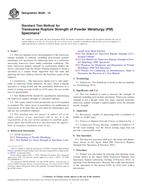Potřebujeme váš souhlas k využití jednotlivých dat, aby se vám mimo jiné mohly ukazovat informace týkající se vašich zájmů. Souhlas udělíte kliknutím na tlačítko „OK“.
ASTM E159-10
Standard Test Method for Loss of Mass in a Reducing Gas Atmosphere for Cobalt, Copper, Tungsten, and Iron Powders (Hydrogen Loss)
Automaticky přeložený název:
Standardní zkušební metoda pro ztrátu hmotnosti v vodíku pro kobalt, měď, wolfram, a železné prášky (Hydrogen ztráty)
NORMA vydána dne 1.7.2010
Informace o normě:
Označení normy: ASTM E159-10
Poznámka: NEPLATNÁ
Datum vydání normy: 1.7.2010
Kód zboží: NS-42280
Počet stran: 3
Přibližná hmotnost: 9 g (0.02 liber)
Země: Americká technická norma
Kategorie: Technické normy ASTM
Kategorie - podobné normy:
Anotace textu normy ASTM E159-10 :
Keywords:
chemical analysis, cobalt powder, copper powder, hydrogen loss, iron powder, metal powders, oxygen content, tungsten powder, Chemical analysis, Copper powder, Hydrogen content--metals/alloys, Hydrogen loss, Iron powder, Metal powders, Oxides (hydrogen reducible), Tungsten powder, ICS Number Code 77.160 (Powder metallurgy)
Doplňující informace
| Significance and Use | ||||||||
|
The oxygen content of a powder affects both its green and sintered properties. Hydrogen loss is a term widely used in the powder metallurgy industry even though the measurement represents an approximate oxygen content of the powder. Oxygen is the most common hydrogen-reducible constituent of metal powders, and this procedure may be used as a measure of oxygen, reducible under the test conditions, if other interfering elements are absent. |
||||||||
| 1. Scope | ||||||||
|
1.1 This test method covers the determination of the mass of hydrogen-reducible constituents in the following metal powders: cobalt, copper, iron, and tungsten. 1.2 This test method is useful for cobalt, copper, and iron powders in the range from 0.05 to 3.0 % oxygen, and for tungsten powder in the range from 0.01 to 0.50 % oxygen. 1.3 This test method does not measure the oxygen contained in oxides such as silicon oxide (SiO2), aluminum oxide (Al2O3), magnesium oxide (MgO), calcium oxide (CaO), titanium dioxide (TiO2), etc. that are not reduced by hydrogen at the test temperatures. 1.4 For total oxygen content, vacuum or inert gas fusion methods are available (see Test Methods E1019). 1.5 The values stated in SI units are to be regarded as the standard. 1.6 This standard does not purport to address all of the safety concerns, if any, associated with its use. It is the responsibility of the user of this standard to establish appropriate safety and health practices and determine the applicability of regulatory limitations prior to use. |
||||||||
| 2. Referenced Documents | ||||||||
|
Podobné normy:
Historická
1.10.2010
Historická
1.4.2008
Historická
1.9.2010
Historická
1.10.2013
Historická
1.4.2014
Historická
1.11.2012
Odebírejte informace o nově vydaných normách ZDARMA:
Chcete pravidelně odebírat informace o nově vycházejících normách z celého světa a to zcela zdarma?
Přihlašte se k odběru. Vše je velice jednoduché a absolutně ZDARMA.
Na výběr máte vydavatele z celého světa.



 ASTM B331-10
ASTM B331-10 ASTM B362-91(2008)..
ASTM B362-91(2008).. ASTM B406-96(2010)..
ASTM B406-96(2010).. ASTM B417-13
ASTM B417-13 ASTM B527-14
ASTM B527-14 ASTM B528-12
ASTM B528-12
 Cookies
Cookies
